Climate Data to Undertake Hygrothermal and Whole Building Simulations Under Projected Climate Change Influences for 11 Canadian Cities
Abstract
:1. Introduction
2. Methods
2.1. Selected Cities
2.2. Generated Climate Variables
2.3. Methodology
2.4. Data Sources
2.4.1. Climate Observations
2.4.2. Climate Model Simulations
2.5. Derived Variables
- The horizontal components of the hourly extra-terrestrial solar radiation (Xtr) were calculated, and their ratio (Xtr/GHI) was calculated to obtain the clearness index (kT).
- The values of kT were used to calculate the diffused fraction kd using the method of [36], described in Equation (3):
- The values of DHI and DRI were calculated using Equations (4) and (5) respectively:
- The values of DNI were calculated using Equation (6):where θ denotes the solar elevation angle.
2.6. Bias-correction of Climate Model Data
- (i)
- The temperature, relative humidity, wind speed, wind direction, pressure, and cloud-cover were corrected using bias correction factors that capture the differences between the modelled and observed means of these variables for each hour and month combination. By comparing the merged observational and CanRCM4 LE climate data, the additive correction factors were derived for the temperature, relative humidity, wind direction, and cloud-cover, whereas the multiplicative correction factors were derived for the wind speed and pressure. The derived bias-correction factors were later added (in the case of the temperature, relative humidity, wind direction, and cloud-cover) and multiplied (in the case of the wind speed and pressure variables) with CanRCM4 LE projections to obtain the bias corrected projections.
- (ii)
- With respect to the rainfall, the bias associated with the total number of wet hours and magnitudes of the rainfall events simulated by CanRCM4 LE were corrected. The bias correction factors were derived for each month, and only days with no missing observational rainfall values were considered for the estimation of the bias-correction parameters.It was noted that CanRCM4 LE tended to have a negative wet hour bias i.e., the number of wet hours simulated by the model were greater than the observations; this is similar to the bias evident for many other RCMs [37,38]. The procedure adopted to correct this bias was as follows [38]:
- The observational and model rainfall intensities were sorted in a decreasing order.
- The point at which the observations reached above zero provided the corresponding threshold intensity Rth of the CanRCM4 LE model.
- The Rth is then subtracted from each of the hourly rainfall values and truncated at zero so that the numbers of dry hours are identical for both the model and observational data.
- The corrected hourly rainfall is then:
Following the wet hour number bias correction, the bias of the rainfall magnitude simulated by the model is corrected using the ratio of the rainfall present in the observations and using the ratio simulated by the model:where and denote, respectively, the average rainfall in the observations and the wet hour corrected modelled rainfall. - (iii)
- To obtain the bias-corrected CanRCM4 LE snow-cover data, corrections were made to the CanRCM4 LE derived snow-depths that were later converted to the snow-cover using Equation (2). The bias correction factors were derived for each month, and only days with no missing observational snow-depth values were considered for the estimation of the bias-correction parameters.When a negative bias was associated with the total number of simulated snow hours, the procedure used to correct the negative bias in the total numbers of wet rainfall hours was used for the bias-correction of the snow hours.When a positive bias was associated with the total number of simulated snow hours, i.e., the numbers of snow hours simulated by the model were smaller than the observations, the number of wet hours in CanRCM4 LE needed to be increased. The increase in, for example, the Nwd number of wet hours was introduced by first calculating the 24-h running mean of the snow-depth using the CanRCM4 snow-depth data, and thereafter converting the Nwd no-snow events with the highest 24-h snow depths into the snow events.
- (iv)
- With regard to the solar radiation, multiplicative bias-correction factors were initially derived for each month and hour combination (as in 2.6i); however, it was noted that the bias-correction factors for the early morning and late evening hours were not stable due to the lack of non-zero solar data for those hours. Another observation made from the initial sets of bias-correction factors derived for each hour and month was that their values were consistently greater than 1 (i.e., the model under-predicted the global solar radiation) for the hours until noon and under 1 (i.e., the model over-predicted the global solar radiation) for the hours after noon. Therefore, in an effort to obtain more robust sets of bias-correction factors, two bias-correction factors were derived for each month: one was derived for the hours 0–12 and another was derived for the hours 13–23.
3. Analysis and Discussion
3.1. Validation of Bias Correction Procedure
3.2. Projected Changes in Climate Under 2 °C and 3.5 °C Global Warming
4. Conclusions
Supplementary Materials
Author Contributions
Funding
Acknowledgments
Conflicts of Interest
References
- Bindoff, N.L.; Stott, P.A.; AchutaRao, K.M.; Allen, M.R.; Gillett, N.; Gutzler, D.; Hansingo, K.; Hegerl, G.; Hu, Y.; Jain, S.; et al. Detection and Attribution of Climate Change: From Global to Regional. In Climate Change 2013: The Physical Science Basis. Contribution of Working Group I to the Fifth Assessment Report of the Intergovernmental Panel on Climate Change; Stocker, T.F., Qin, D., Plattner, G.K., Tignor, M., Allen, S.K., Boschung, J., Nauels, A., Xia, Y., Bex, V., Midgley, P.M., Eds.; Cambridge University Press: Cambridge, UK, 2013. [Google Scholar]
- Collins, M.; Knutti, R.; Arblaster, J.; Dufresne, J.-L.; Fichefet, T.; Friedlingstein, P.; Gao, X.; Gutowski, W.J.; Johns, T.; Krinner, G.; et al. Long-term Climate Change: Projections, Commitments and Irreversibility. In Climate Change 2013: The Physical Science Basis. Contribution of Working Group I to the Fifth Assessment Report of the Intergovernmental Panel on Climate Change; Stocker, T.F., Plattner, G.-K., Tignor, M., Allen, S.K., Boschung, J., Nauels, A., Xia, Y., Bex, V., Midgley, P.M., Eds.; Cambridge University Press: Cambridge, UK, 2013. [Google Scholar]
- Bizikova, L.; Neale, T.; Burton, I. Canadian Communities’ Guidebook for Adaptation to Climate Change: Including an Approach to Generate Mitigation Co-Benefits in the Context of Sustainable Development, 1st ed.; Environment Canada and University of British Columbia: Vancouver, BC, Canada, 2008. [Google Scholar]
- Zhang, X.; Flato, G.; Kirchmeier-Young, M.; Vincent, L.; Wan, H.; Wang, X.; Rong, R.; Fyfe, J.; Li, G.; Kharin, V.V. Changes in Temperature and Precipitation Across Canada. In Canada’s Changing Climate Report; Bush, E., Lemmen, D.S., Eds.; Government of Canada: Ottawa, ON, Canada, 2019; pp. 112–193. [Google Scholar]
- Nik, V.M.; Mundt-Petersen, S.; Kalagasidis, A.S.; Wilde, P. Future moisture loads for building facades in Sweden: Climate change and wind-driven rain. Build. Environ. 2015, 93, 362–375. [Google Scholar]
- Huijbregts, Z.; Kramer, R.P.; Martens, M.H.J.; van Schijndel, A.W.M.; Schellen, H.L. A proposed method to assess the damage risk of future climate change to museum objects in historic buildings. Build. Environ. 2012, 55, 43–56. [Google Scholar] [CrossRef]
- Tian, W.; Wilde, P. Uncertainty and sensitivity analysis of building performance using probabilistic climate projections: A UK case study. Autom. Constr. 2011, 20, 1096–1109. [Google Scholar] [CrossRef]
- Huang, C.; Barnett, A.G.; Wang, X.; Vaneckova, P.; FitzGerald, G.; Tong, S. Projecting Future Heat-Related Mortality under Climate Change Scenarios: A Systematic Review. Environ Health Perspect. 2011, 119, 1681–1690. [Google Scholar] [CrossRef] [PubMed] [Green Version]
- Sanderson, M.; Arbuthnott, K.; Kovats, S.; Hajat, S.; Falloon, P. The use of climate information to estimate future mortality from high ambient temperature: A systematic literature review. PLoS ONE 2017, 12, e0180369. [Google Scholar] [CrossRef] [PubMed]
- Lankester, P.; Brimblecombe, P. The impact of future climate on historic interiors. Sci. Total. Environ. 2012, 417, 248–254. [Google Scholar] [CrossRef]
- Wilde, P.; Tian, W. Predicting the performance of an office under climate change: A study of metrics, sensitivity and zonal resolution. Energy Build. 2010, 42, 1674–1684. [Google Scholar] [CrossRef]
- Hamdy, M.; Carlucci, S.; Hoes, P.-J.; Hensen, J.L.M. The impact of climate change on the overheating risk in dwellings: A Dutch case study. Build. Environ. 2017, 122, 307–323. [Google Scholar] [CrossRef]
- Nik, V.M. Application of typical and extreme weather data sets in thehygrothermal simulation of building components for future climate—A case study for a wooden frame wall. Energy Build. 2017, 154, 30–45. [Google Scholar] [CrossRef]
- Carli, R.; Dotoli, M. Energy scheduling of a smart home under nonlinear pricing. In Proceedings of the 2015 IEEE 54th Annual Conference on Decision and Control (CDC), Osaka, Japan, 15–18 December 2015; pp. 5648–5653. [Google Scholar]
- Kim, J.-H.; Kim, H.-R.; Kim, J.-T. Analysis of Photovoltaic Applications in Zero Energy Building Cases of IEA SHC/EBC Task 40/Annex 52. Sustainability 2015, 7, 8782–8800. [Google Scholar] [CrossRef] [Green Version]
- Hosseini, S.M.; Carli, R.; Dotoli, M. Model Predictive Control for Real-Time Residential Energy Scheduling under Uncertainties. In Proceedings of the 2018 IEEE International Conference on Systems, Man, and Cybernetics (SMC), Miyazaki, Japan, 7–10 October 2018; pp. 1386–1391. [Google Scholar]
- D’Agostino, D.; Zangheri, P.; Castellazzi, L. Towards Nearly Zero Energy Buildings in Europe: A Focus on Retrofit in Non-Residential Buildings. Energies 2017, 10, 117. [Google Scholar] [CrossRef]
- Tewari, M.; Palou, F.S.; Martilli, A.; Treinish, A.; Mahalov, A. Impacts of projected urban expansion and global warming on cooling energy demand over a semiarid region. Atmos. Sci. Lett. 2017, 18, 419–426. [Google Scholar] [CrossRef] [Green Version]
- Salamanca, F.; Georgescu, M.; Mahalov, A.; Moustaoui, M.; Martilli, A. Citywide impacts of cool roof and rooftop solar photovoltaic deployment on near-surface air temperature and cooling energy demand. Bound. Layer Meteorol. 2016. [Google Scholar] [CrossRef]
- Salamanca, F.; Georgescu, M.; Mahalov, A.; Moustaoui, M. Summertime response of temperature and cooling energy demand to urban expansion in a semiarid environment. J. Appl. Meteorol. Climatol. 2015, 54, 1756–1772. [Google Scholar] [CrossRef]
- Tato, J.H.; Brito, M.C. Using Smart Persistence and Random Forests to Predict Photovoltaic Energy Production. Energies 2019, 12, 100. [Google Scholar] [CrossRef]
- Foley, A.M.; Leahy, P.G.; Marvuglia, A.; McKeogh, E.J. Current methods and advances in forecasting of wind power generation. Renew. Energy 2012, 37, 1–8. [Google Scholar] [CrossRef] [Green Version]
- Morris, R. Final Report—Updating CWEEDS Weather Files. Contractor’s Report to Environment Canada 2016, Contract # 3000607888. Available online: ftp://client_climate@ftp.tor.ec.gc.ca/Pub/Engineering_Climate_Dataset/Canadian_Weather_Energy_Engineering_Dataset_CWEEDS/ENGLISH/Final%20Report%20Updating%20CWEEDS%20Files%20Rev%2020160711.zip (accessed on 18 April 2019).
- Nakićenović, N.; Alcamo, J.; Grubler, A.; Riahi, K.; Roehrl, R.A.; Rogner, H.H.; Victor, N. Special Report on Emissions Scenarios: A Special Report of Working Group III of the Intergovernmental Panel on Climate Change; Cambridge University Press: Cambridge, UK, 2000. [Google Scholar]
- Karagiozis, A. Overview of the 2-D Hygrothermal Heat-Moisture Transport Model LATENITE; Internal IRC/BPL Rep.; National Research Council Canada: Ottawa, ON, Canada, 1993.
- Djebbar, R.; Kumaran, M.K.; Van Reenen, D.; Tariku, F. Hygrothermal Modeling of Building Envelope Retrofit Measures in Multiunit Residential and Commercial Office Buildings; Client Final Rep. No. B-1110.3; IRC/NRC, National Research Council: Ottawa, ON, Canada, 2002; p. 187.
- Crawley, D.; Lawrie, L.; Winkelmann, F.; Buhl, W.; Huang, J.Y.; Pedersen, C.; Strand, R.K.; Liesen, R.J.; Fisher, D.E.; et al. EnergyPlus: Creating a new-generation building energy simulation program. Energy Build. 2001, 33, 319–331. [Google Scholar] [CrossRef]
- Nicolai, A.; Grunewald, J.; Zhang, J.S. Salztransport und Phasenumwandlung - Modellierung und numerische Lösung im Simulationsprogramm Delphin 5. Build. Phys. 2007, 29, 231–239. [Google Scholar] [CrossRef]
- Künzel, H.M. Verfahren zur ein- und zweidimensionalen Berechnung des gekoppelten Wärme- und Feuchtetransports in Bauteilen mit einfachen Kennwerten; University Stuttgart: Stuttgart, Germany, 1994; Available online: http://publica.fraunhofer.de/eprints/urn_nbn_de_0011-n-692166.pdf (accessed on 18 April 2019).
- ECCC, Environment and Climate Change Canada. Memorandum of Understanding between National Research Council and Environment and Climate Change Canada on Climate Resilient Buildings and Core Public Infrastructure: Future Projections of Climate Design Values. Tier 1 Climate Projections; Government of Canada: Ottawa, ON, Canada, 2018; 48p.
- Arora, V.; Scinocca, J.; Boer, G.; Christian, J.; Denman, K.; Flato, G.; Kharin, V.; Lee, W.; Merryfield, W. Carbon emission limits required to satisfy future representative concentration pathways of greenhouse gases. Geophys. Res. Lett. 2011, 38. [Google Scholar] [CrossRef] [Green Version]
- Fyfe, J.C.; Derksen, C.; Mudryk, L.; Flato, G.M.; Santer, B.D.; Swart, N.C.; Molotch, N.P.; Zhang, X.; Wan, H.; Arora, V.K.; et al. Large near-term projected snowpack loss over the western United States. Nat. Commun. 2017, 8. [Google Scholar] [CrossRef]
- Van Vuuren, D.P.; Edmonds, J.; Kainuma, M.; Riahi, K.; Thomson, A.; Hibbard, K.; Hurtt, G.C.; Kram, T.; Krey, V.; Lamarque, J.-F.; et al. The representative concentration pathways: An overview. Clim. Chang. 2011, 109, 5–31. [Google Scholar] [CrossRef]
- Scinocca, J.; Kharin, V.; Jiao, Y.; Qian, M.; Lazare, M.; Solheim, L.; Flato, G.; Biner, S.; Desgagne, M.; Dugas, B. Coordinated global and regional climate modeling. J. Clim. 2016, 29, 17–35. [Google Scholar] [CrossRef]
- WMO. WMO Guidelines of the Calculation of Climate Normals; WMO-No. 1203; World Meteorological Organization: Geneva, Switzerland, 2017; Available online: https://library.wmo.int/doc_num.php?explnum_id=4166 (accessed on 18 April 2019).
- Orgill, J.F.; Hollands, K.G.T. Correlation equation for hourly diffuse radiation on a horizontal surface. Sol. Energy 1977, 19, 357–359. [Google Scholar] [CrossRef]
- Bordoy, R.; Burlando, P. Bias Correction of Regional Climate Model Simulations in a Region of Complex Orography. J. Appl. Meteorol. Climatol. 2013, 52, 82–101. [Google Scholar] [CrossRef]
- Berg, P.; Feldmann, H.; Panitz, H.J. Bias correction of high resolution regional climate model data. J. Hydrol. 2012, 448, 80–92. [Google Scholar] [CrossRef]
- Leander, R.; Buishand, A. Resampling of regional climate model output for the simulation of extreme river flows. J. Hydrol. 2006, 332, 487–496. [Google Scholar] [CrossRef]
- Li, H.; Sheffield, J.; Wood, E. Bias correction of monthly precipitation and temperature fields from Intergovernmental Panel on Climate Change AR4 models using equidistant quantile matching. J. Geophys. Res. 2010, 115, 20. [Google Scholar] [CrossRef]
- Piani, C.; Weedon, G.; Best, M.; Gomes, S.; Viterbo, P.; Hagemann, S.; Haerter, J. Statistical bias correction of global simulated daily precipitation and temperature for the application of hydrological models. J. Hydrol. 2010, 395, 199–215. [Google Scholar] [CrossRef]
- Ashfaq, M.; Bowling, L.; Cherkauer, K.; Pal, J.; Diffenbaugh, N. Influence of climate model biases on daily-scale temperature and precipitation events on hydrological impacts assessment: A case study of the United States. J. Geophys. Res. 2010, 115, 15. [Google Scholar] [CrossRef]
- Cannon, A. Multivariate quantile mapping bias correction: An N-dimensional probability density function transform for climate model simulations of multiple variables. Clim. Dyn. 2018, 50, 31–49. [Google Scholar] [CrossRef]
- Gaur, A.; Eichenbaum, M.K.; Simonovic, S.P. Analysis and modelling of surface Urban Heat Island in 20 Canadian cities under climate and land-cover change. J. Environ. Manag. 2018, 206, 145–157. [Google Scholar] [CrossRef] [PubMed]
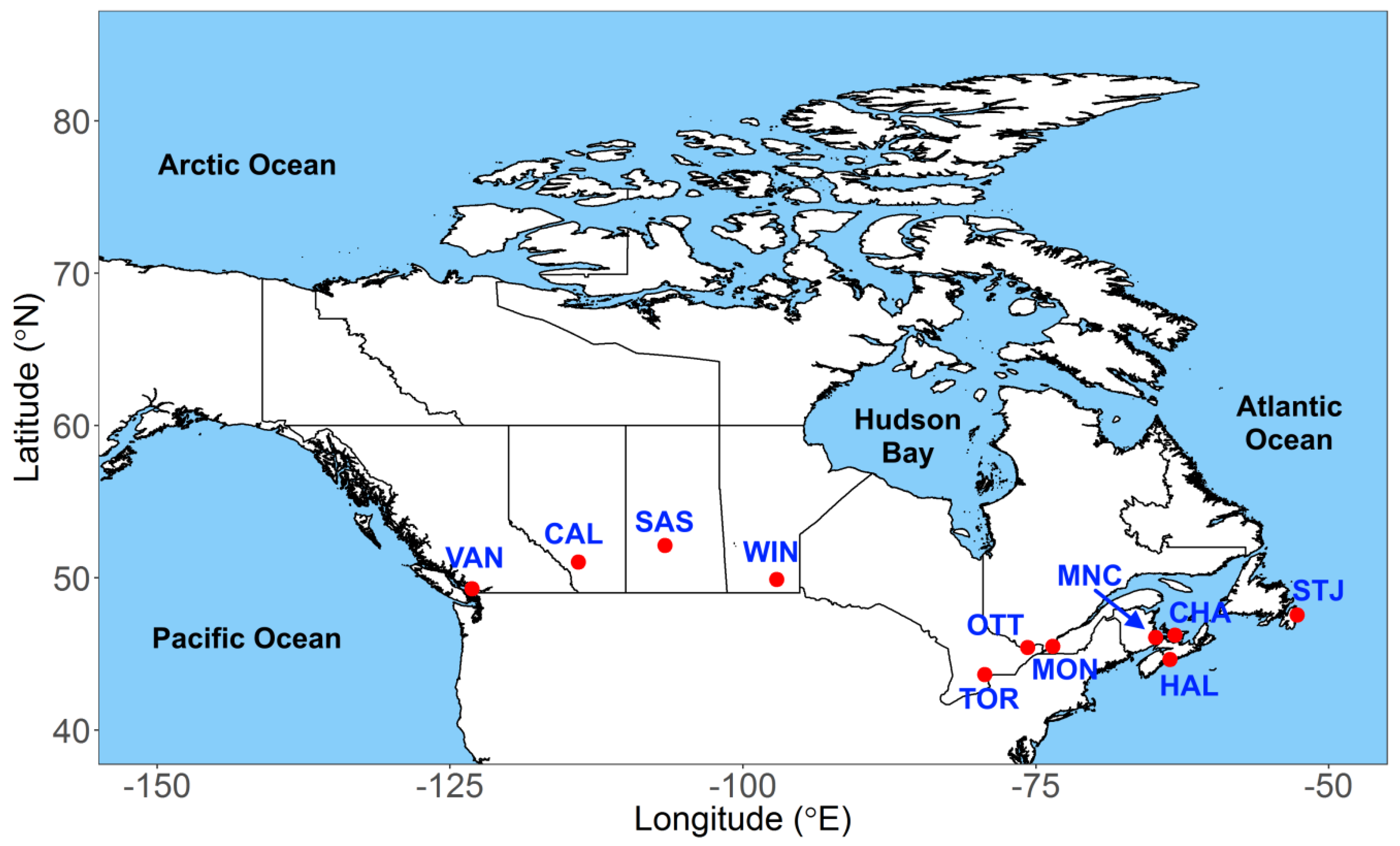
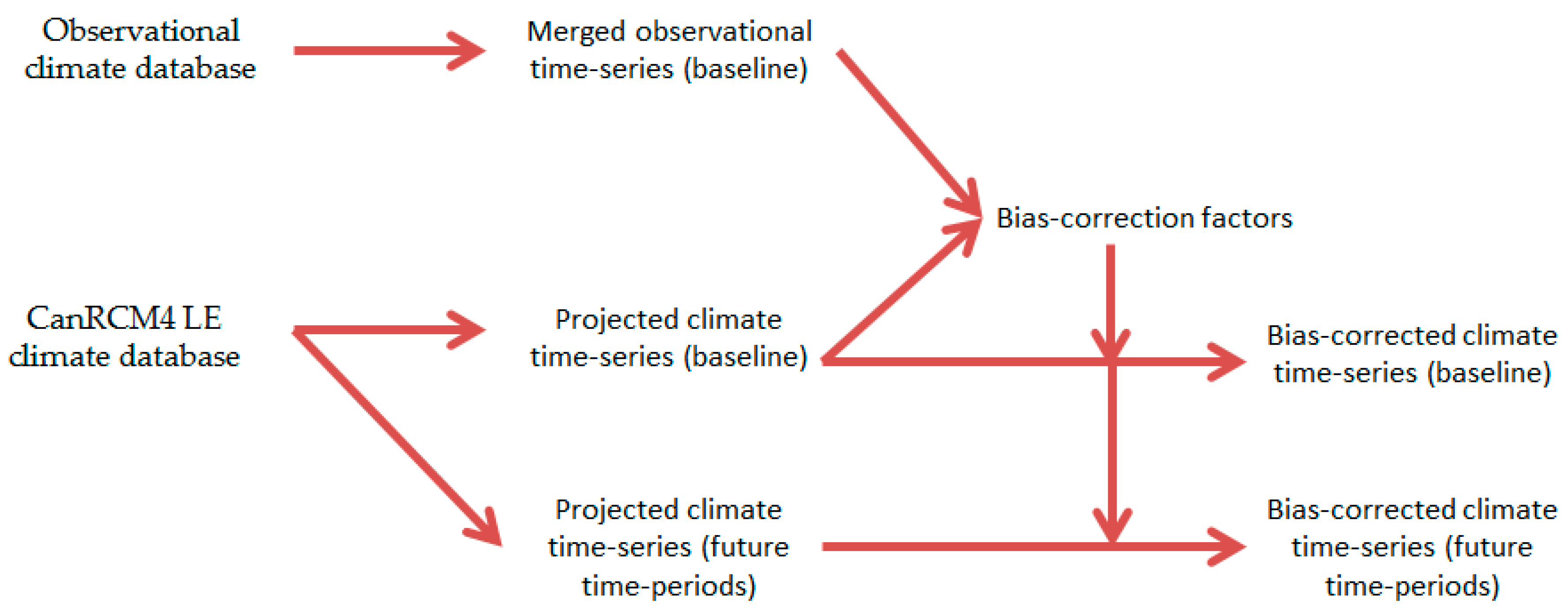
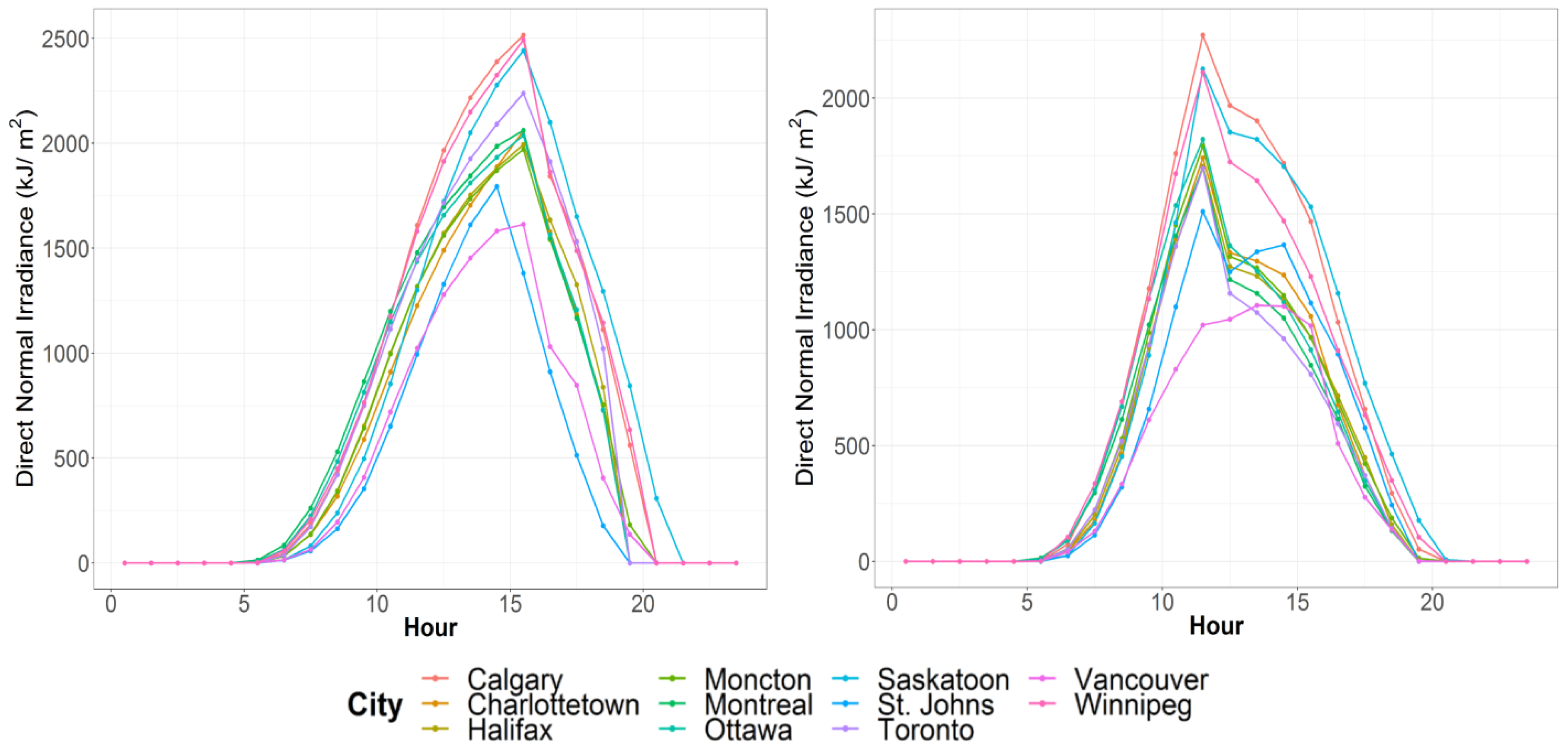
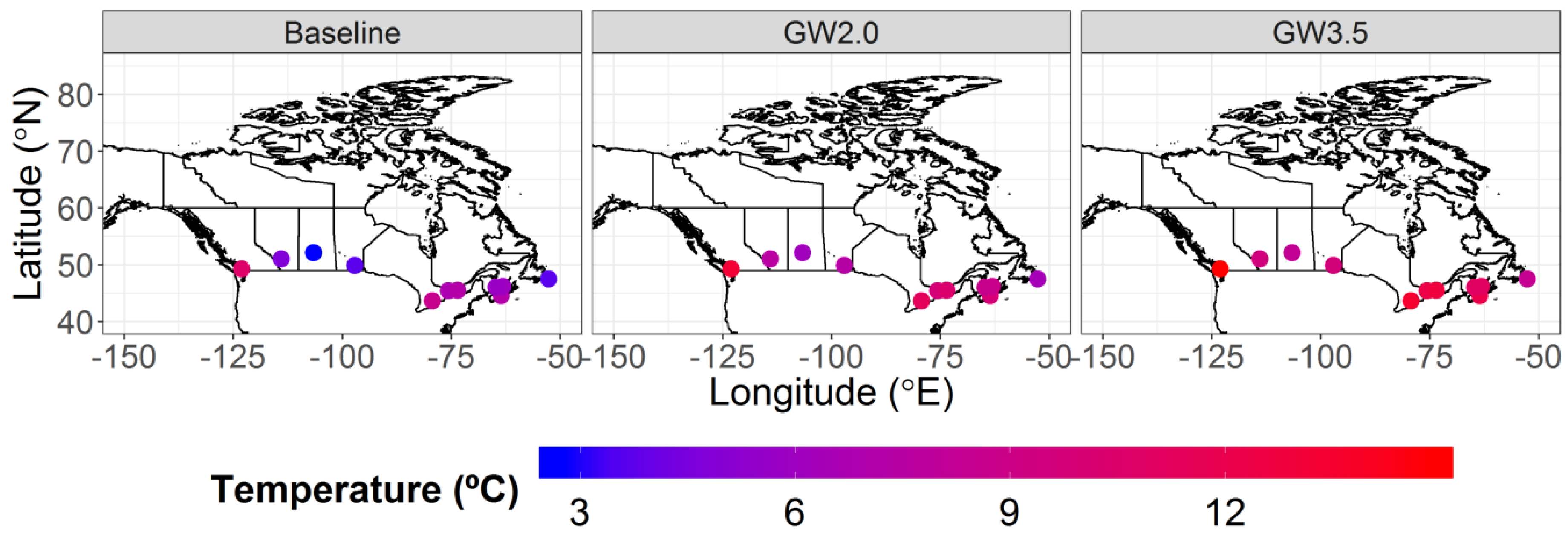
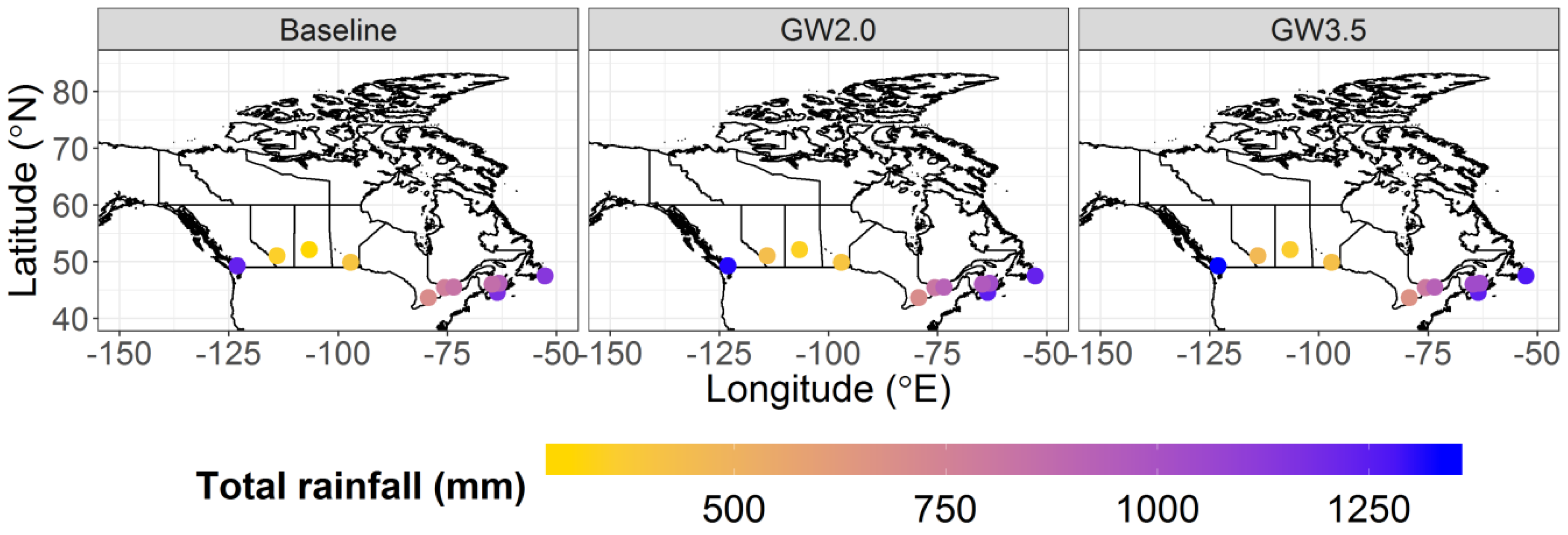
| S. No. | City (SHORTNAME) | Latitude (°N) | Longitude (°E) | Population in 2016 (1000s) | Climate Zone |
|---|---|---|---|---|---|
| 1 | Calgary (CAL) | 51.0 | −114.1 | 1237.7 | Prairies/South British Columbia Mountains |
| 2 | Charlottetown (CHA) | 46.2 | −63.1 | 44.7 | Atlantic |
| 3 | Halifax (HAL) | 44.6 | −63.6 | 316.7 | Atlantic |
| 4 | Moncton (MNC) | 46.1 | −64.8 | 108.6 | Atlantic |
| 5 | Montreal (MON) | 45.5 | −73.6 | 1705.0 | Great lakes/St. Lawrence lowlands |
| 2 | Ottawa (OTT) | 45.4 | −75.7 | 934.2 | Great lakes/St. Lawrence lowlands |
| 3 | Saskatoon (SAS) | 52.1 | −106.7 | 246.4 | Prairies |
| 4 | St. Johns (STJ) | 47.6 | −52.7 | 206.0 | Atlantic |
| 5 | Toronto (TOR) | 43.7 | −79.4 | 2731.6 | Great lakes/St. Lawrence lowlands |
| 10 | Vancouver (VAN) | 49.3 | −123.1 | 2463.4 | Pacific coast/South British Columbia Mountains |
| 11 | Winnipeg (WIN) | 49.9 | −97.1 | 711.9 | Prairies |
| S. No. | Climate Variable | Units | Source (Observations) | Source (CanESM2-LE) |
|---|---|---|---|---|
| 1 | Direct Horizontal Irradiance | kJ/m2 | Hourly global horizontal irradiance | Hourly downward shortwave radiative flux |
| 2 | Diffused Horizontal Irradiance | kJ/m2 | ||
| 3 | Direct Normal Irradiance | kJ/m2 | ||
| 4 | Global Horizontal Irradiance | kJ/m2 | ||
| 5 | Total Cloud Cover | % | Hourly total cloud cover | Hourly total cloud cover |
| 6 | Rainfall | mm | Hourly rainfall | Hourly precipitation, daily solid precipitation |
| 7 | Wind direction | Degrees clockwise from north | Hourly wind direction | Hourly U and V components of wind |
| 8 | Wind speed | m/s | Hourly wind speed | |
| 9 | Relative humidity | % | Hourly relative humidity | Hourly relative humidity |
| 10 | Temperature | °C | Hourly temperature | Hourly temperature |
| 11 | Atmospheric Pressure | Pa | Hourly atmospheric Pressure | Hourly atmospheric Pressure |
| 12 | Snow-cover | 0 (no snow) or 1 (snow) | Daily snow depth | Daily snow depth |
| Statistic | GHI (%) | TCC (%) | RAIN (%) | WDIR (°) | WSP (%) | RHUM (%) | TEMP (°C) | ATMPR (%) | SNOW HOURS (%) |
|---|---|---|---|---|---|---|---|---|---|
| Calgary | |||||||||
| Mean | −0.9 | 0.6 | 16.4 | −0.9 | −3.1 | 1.0 | 2.7 | 0.1 | −21.7 |
| Max | 1.2 | 2.0 | 24.9 | 0.6 | −0.1 | 1.9 | 3.2 | 0.1 | 11.9 |
| Min | −2.7 | −0.7 | 1.1 | −2.1 | −6.0 | −0.3 | 2.1 | 0.1 | −44.3 |
| Charlottetown | |||||||||
| Mean | 1.5 | −1.3 | 8.7 | −0.9 | −1.2 | 0.2 | 2.9 | 0 | −48.8 |
| Max | 2.9 | -0.4 | 14.7 | 0.3 | −0.4 | 0.6 | 3.3 | 0.1 | −39.8 |
| Min | 0.4 | −2.2 | 2.5 | −3.7 | −2.5 | 0 | 2.5 | 0 | −64.8 |
| Halifax | |||||||||
| Mean | 0.5 | 0.2 | 6.3 | −0.9 | −1.2 | 0.9 | 2.8 | 0 | −65.6 |
| Max | 1.6 | 1.0 | 10.2 | 0.5 | −0.5 | 1.2 | 3.2 | 0.1 | −56.0 |
| Min | −0.4 | −0.4 | 2.4 | −3.7 | −2.5 | 0.6 | 2.4 | 0 | −79.6 |
| Moncton | |||||||||
| Mean | 0.1 | 0.2 | 10.5 | −0.7 | −0.8 | 1.6 | 2.9 | 0 | −45.4 |
| Max | 2.0 | 1.0 | 17.1 | 0.9 | 0 | 2.1 | 3.4 | 0.1 | −37.1 |
| Min | −0.8 | −1.1 | 3.0 | −2.4 | −2.3 | 1.2 | 2.6 | 0 | −60.3 |
| Montreal | |||||||||
| Mean | 0.5 | 0.4 | 9.4 | −0.7 | −1.0 | 0.7 | 3.1 | 0 | −40.8 |
| Max | 2.2 | 1.4 | 14.8 | 0.9 | 0.6 | 1.3 | 3.6 | 0 | −30.0 |
| Min | −0.5 | −0.8 | 1.7 | −3.3 | −1.9 | 0.1 | 2.6 | 0 | −52.7 |
| Ottawa | |||||||||
| Mean | 0.3 | 0.5 | 8.1 | −0.4 | −1.1 | 0.9 | 3.1 | 0 | −33.5 |
| Max | 1.9 | 1.5 | 15.4 | 1.6 | 0.2 | 1.6 | 3.6 | 0 | −24.4 |
| Min | −1.1 | −0.5 | 1.9 | −2.9 | −2.0 | 0.3 | 2.5 | 0 | −44.9 |
| Saskatoon | |||||||||
| Mean | −1.0 | 0.9 | 10.2 | −2.1 | −2.3 | 0.5 | 3.1 | 0.1 | −41.9 |
| Max | 0 | 1.7 | 18.3 | 0 | −0.1 | 1.4 | 3.8 | 0.1 | −28.2 |
| Min | −2.1 | −0.2 | −1.6 | −3.5 | −4.0 | −0.5 | 2.5 | 0 | −53.9 |
| St. Johns | |||||||||
| Mean | 1.1 | −0.3 | 4.0 | 0.2 | −1.1 | 0.2 | 2.6 | 0 | −62.4 |
| Max | 3.5 | 0.8 | 11.4 | 2.0 | −0.1 | 0.9 | 3.0 | 0.1 | −50.7 |
| Min | −1.1 | −1.0 | −4.4 | −1.4 | −2.2 | −0.1 | 2.3 | 0 | −74.1 |
| Toronto | |||||||||
| Mean | 1.2 | 0.2 | 3.1 | −1.0 | −2.8 | 0.1 | 2.7 | 0 | −47.7 |
| Max | 2.3 | 1.0 | 14.5 | 1.2 | −1.4 | 0.8 | 3.1 | 0 | −39.2 |
| Min | 0.2 | −1.1 | −7.1 | −3.5 | −3.5 | −0.5 | 2.3 | 0 | −58.4 |
| Vancouver | |||||||||
| Mean | 1.3 | 0 | 3.9 | −1.0 | −3.0 | 0.5 | 2.6 | 0 | −99.6 |
| Max | 2.9 | 1.5 | 12.0 | 1.3 | −0.5 | 1.0 | 2.9 | 0 | −97.5 |
| Min | −0.5 | −1.6 | −2.4 | −4.3 | −4.9 | 0 | 2.2 | 0 | −100.0 |
| Winnipeg | |||||||||
| Mean | −1.2 | 0.7 | 6.7 | −2.0 | −1.3 | 0.2 | 3.3 | 0 | −20.3 |
| Max | −0.4 | 1.8 | 17.2 | 0.7 | 0.2 | 1.2 | 4.0 | 0.1 | −32.1 |
| Min | −2.0 | −0.5 | −7.2 | −3.4 | −3.2 | −0.7 | 2.8 | 0 | −51.9 |
| Statistic | GHI (%) | TCC (%) | RAIN (%) | WDIR (°) | WSP (%) | RHUM (%) | TEMP (°C) | ATMPR (%) | SNOW HOURS (%) |
|---|---|---|---|---|---|---|---|---|---|
| Calgary | |||||||||
| Mean | −1.3 | 1.0 | 22.7 | −1.8 | −5.4 | 1.4 | 4.8 | 0.2 | −45.3 |
| Max | 0.1 | 2.6 | 34.3 | 0.7 | −3.6 | 3.0 | 5.2 | 0.2 | −33.3 |
| Min | −3.8 | 0 | 9.8 | −3.8 | −7.8 | 0.4 | 4.5 | 0.2 | −56.3 |
| Charlottetown | |||||||||
| Mean | 1.6 | −1.4 | 13.4 | −1.9 | −2.6 | 0.5 | 4.8 | 0 | −74.4 |
| Max | 2.8 | −0.5 | 19.6 | −0.2 | −1.7 | 0.9 | 5.2 | 0.1 | −63.0 |
| Min | 1.0 | −2.0 | 7.2 | −4.1 | −4.3 | 0.1 | 4.3 | 0 | −86.6 |
| Halifax | |||||||||
| Mean | 0 | 0.7 | 9.7 | −2.3 | −2.6 | 1.7 | 4.7 | 0.1 | −87.2 |
| Max | 0.8 | 1.7 | 16.7 | 0 | −1.5 | 1.9 | 5.1 | 0.1 | −79.8 |
| Min | −1.1 | 0 | 2.6 | −4.1 | −3.8 | 1.4 | 4.4 | 0 | −92.7 |
| Moncton | |||||||||
| Mean | −0.5 | 0.7 | 17.5 | −1.7 | −2.0 | 3.1 | 5.0 | 0 | −76.5 |
| Max | 0.3 | 1.6 | 23.0 | 0.4 | −0.7 | 3.5 | 5.4 | 0.1 | −66.0 |
| Min | −1.6 | 0 | 10.1 | −3.1 | −3.1 | 2.7 | 4.6 | 0 | −84.9 |
| Montreal | |||||||||
| Mean | −0.1 | 1.0 | 16.8 | −2.2 | −2.4 | 1.5 | 5.2 | 0 | −68.9 |
| Max | 0.6 | 1.8 | 25.3 | −0.9 | −1.3 | 1.9 | 5.6 | 0 | −60.6 |
| Min | −0.8 | 0.1 | 9.6 | −3.7 | −3.6 | 1.0 | 4.8 | 0 | −76.1 |
| Ottawa | |||||||||
| Mean | −0.5 | 1.2 | 14.4 | −1.8 | −2.2 | 1.8 | 5.2 | 0 | −62.5 |
| Max | 0.5 | 1.8 | 21.0 | 0.7 | −1.0 | 2.3 | 5.6 | 0 | −53.4 |
| Min | −1.5 | 0.5 | 5.7 | −4.3 | −3.5 | 1.2 | 4.8 | 0 | −73.8 |
| Saskatoon | |||||||||
| Mean | −1.8 | 1.6 | 15.5 | −3.7 | −4.2 | 0.8 | 5.4 | 0.1 | −22.6 |
| Max | −0.3 | 3.4 | 32.3 | −2.1 | −2.5 | 2.3 | 5.8 | 0.1 | −8.0 |
| Min | −3.2 | 0.8 | 6.9 | −6.1 | −6.0 | −0.3 | 5.0 | 0 | −41.8 |
| St. Johns | |||||||||
| Mean | 2.7 | −0.7 | 7.6 | −0.1 | −2.1 | 0.3 | 4.7 | 0 | −89.3 |
| Max | 4.4 | 0.3 | 15.7 | 2.6 | −1.4 | 1.0 | 5.0 | 0.1 | −77.1 |
| Min | 0.9 | −1.5 | 1.8 | −2.2 | −2.8 | 0 | 4.3 | 0 | −96.2 |
| Toronto | |||||||||
| Mean | 0.8 | 1.0 | 6.5 | −2.6 | −5.1 | 0.5 | 4.7 | 0 | −76.2 |
| Max | 1.8 | 1.6 | 15.3 | −0.2 | −3.6 | 1.0 | 4.9 | 0 | −69.7 |
| Min | −0.1 | −0.1 | 0.5 | −4.4 | −6.3 | −0.1 | 4.3 | 0 | −82.7 |
| Vancouver | |||||||||
| Mean | 2.5 | −0.4 | 4.4 | −2.0 | −5.8 | 0.5 | 4.3 | 0 | −100.0 |
| Max | 3.9 | 0.6 | 9.7 | −0.6 | −4.1 | 1.1 | 4.8 | 0 | −100.0 |
| Min | 0.7 | −1.8 | −2.8 | −4.5 | −7.7 | 0.2 | 4.0 | 0 | −100.0 |
| Winnipeg | |||||||||
| Mean | −2.7 | 1.8 | 14.6 | −2.8 | −2.7 | 0.7 | 5.6 | 0 | −41.5 |
| Max | −1.5 | 2.7 | 29.0 | −0.6 | −0.5 | 2.0 | 6.0 | 0.1 | −32.1 |
| Min | −3.4 | 0.6 | −1.8 | −4.7 | −4.4 | 0 | 5.3 | 0 | −51.9 |
© 2019 by the authors. Licensee MDPI, Basel, Switzerland. This article is an open access article distributed under the terms and conditions of the Creative Commons Attribution (CC BY) license (http://creativecommons.org/licenses/by/4.0/).
Share and Cite
Gaur, A.; Lacasse, M.; Armstrong, M. Climate Data to Undertake Hygrothermal and Whole Building Simulations Under Projected Climate Change Influences for 11 Canadian Cities. Data 2019, 4, 72. https://doi.org/10.3390/data4020072
Gaur A, Lacasse M, Armstrong M. Climate Data to Undertake Hygrothermal and Whole Building Simulations Under Projected Climate Change Influences for 11 Canadian Cities. Data. 2019; 4(2):72. https://doi.org/10.3390/data4020072
Chicago/Turabian StyleGaur, Abhishek, Michael Lacasse, and Marianne Armstrong. 2019. "Climate Data to Undertake Hygrothermal and Whole Building Simulations Under Projected Climate Change Influences for 11 Canadian Cities" Data 4, no. 2: 72. https://doi.org/10.3390/data4020072
APA StyleGaur, A., Lacasse, M., & Armstrong, M. (2019). Climate Data to Undertake Hygrothermal and Whole Building Simulations Under Projected Climate Change Influences for 11 Canadian Cities. Data, 4(2), 72. https://doi.org/10.3390/data4020072






